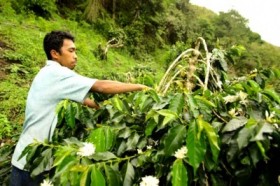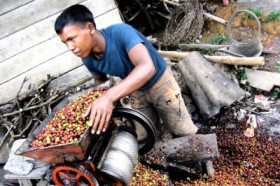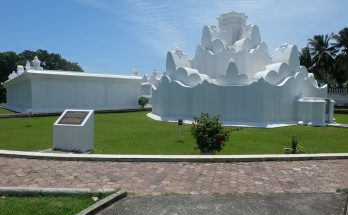
This special coffee comes from the Gayo highlands in Central Aceh, where the crop is organically grown without fertilizers and is widely known as “green beans” for being environmentally friendly.
Lush expanses of predominantly smallholding coffee plantations in the highlands are located in three regencies: Central Aceh, Bener Meriah and Gayo Lues, with, respectively, 48,500 hectares, 39,000 hectares and 7,000 hectares of traditionally managed estates — totaling 94,500 hectares.
Central Aceh is a cool area situated on one part of the Bukit Barisan mountain range, which stretches across the island of Sumatra. The Gayo highlands are also known for its Lake Laut Tawar, which is surrounded by thousands of hectares of vegetation, mostly coffee and pine.
The people of Central Aceh developed the skill of coffee planting with the arrival of Dutch colonizers around 1904. The entry of the Dutch was inseparable from the Gayo region’s potential for the growth of coffee and pine as a source of resin.
According to Win Rudhi Bathin, a Gayo coffee buff from Takengon, Central Aceh, the Dutch introduced coffee to the region and managed coffee estates professionally.
They made the commodity a “product for the future” due to demand in the world market. “So the local community started growing coffee on limited land,” said Win.
In 1924, Dutch and European investors began to dominate Central Aceh with coffee, pine, tea and vegetable estates.
In 1933, some 13,000 hectares had already been planted, with coffee being Holland’s prized commodity and shipped back to Europe. To boost coffee, pine and tea production in the Gayo highlands, the Dutch contracted workers from Java.
“That’s why Central Aceh’s ethnic groups comprise Gayo, Javanese, Batak, Karo, and Aceh people. In some areas like Bener Meriah, the Javanese even remain dominant since being employed there,” added Win Rudhi Bathin.
In the post-colonial war period, the Dutch-owned estates were neglected and taken over by local people. Today, the magnificence of the Dutch plantations has been lost, leaving only their names and history to the Gayo community. “All the estates were seized by and divided among locals,” noted Win.
A village called Bergendal in Gayo is reminiscent of the Dutch presence there. The name derives from the Dutch words bergen en dalen, meaning mountains and valleys. The village lies on a slope where the Dutch started opening their coffee estates, and local villagers still continue to produce high quality coffee.
The most famous coffee shop in Central Aceh is even named Warung Kopi Bergendal, which offers rich-flavored coffee specialties at affordable prices.
Gayo coffee’s entry to the world commodity market is due to its highly valued, typical flavor. Its fine aroma and lack of bitter taste have become the characteristics of this Gayo Arabica product, superior to the flavor of Blue Mountain coffee from Jamaica.
Amir Hamzah, head of the Gayo Coffee Research Agency, said Gayo Arabica coffee cannot be obtained from anywhere else because of the distinctive type of soil in the highlands. Weather conditions and the estates’ 1,200 meter altitude also play a contributory role as both are ideal for growing coffee.
“The varieties grown have a considerable effect upon the coffee’s present quality, which should be maintained,” added Amir Hamzah.
The best and most widely planted varieties are Gayo 1 and Gayo 2. The former is the Timor Leste strain suitable for altitudes of 1,000 — 1,600 meters, and the latter is the Borbor strain, fit for altitudes of less than 1,000 m.
Apart from the superior varieties, the organic method of Gayo coffee planting also makes this commodity a target for world coffee exporters, resulting in its high price due to demand for organic coffee. Almost 80 percent of coffee growers in Central Aceh maintain organic plantations.
“Some of them use chemical fertilizers but not too much, otherwise the coffee price will drop below the standard level,” Amir Hamzah told The Jakarta Post. Any increase in the price of coffee in the world market has a major impact on the economy of Central Aceh and surrounding regencies, as the local populations almost entirely depend on the coffee business for their livelihoods.
Hermanto, head of the Crop Production and Protection Division within the Central Aceh Plantations and Forestry Office, said so far his office has listed 34,476 families of coffee growers in the regency. With the assumption that most families consist of four people, 137,904 people, or nearly 90 percent of its 149,145 people (2010), rely on this trade.
Even in the neighboring province of North Sumatra, 40 out of at least 59 companies that export coffee from Belawan Port are of Central Aceh and Bener Meriah origin. Central Aceh Plantations Office data shows that coffee exports via Belawan in 2008 totaled 54,402 tons, over half of which came from Gayo’s three regencies.
The exceptional taste of Gayo coffee has made it a favorite among coffee drinkers in Europe, especially in the Netherlands. Gayo coffee belongs to the premium category, equal to the class of other world-famous products like Brazilian, Blue Mountain and Ethiopian coffee.
It was its unique flavor that prompted a Dutch entrepreneur to register the trademark of Gayo Mountain Arabica coffee with the World Trade Organization in Europe three years ago.

“It’s very tragic because, as Gayo coffee growers, we can’t sell it without losing its name to a businessman in Holland,” said Hermanto. The Aceh government is striving to regain the Gayo trademark, among others, by issuing the Gayo Arabica Coffee Geographic Indication Right (IG) as solid


